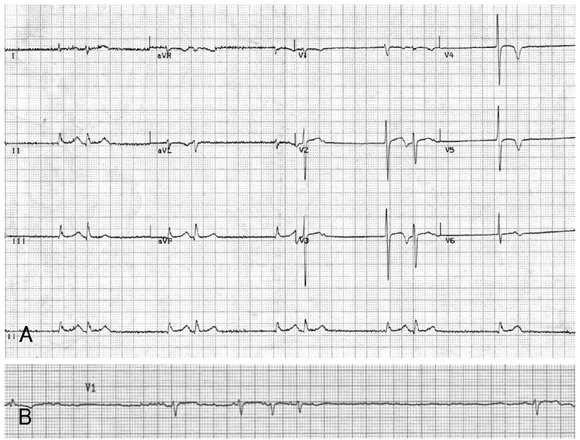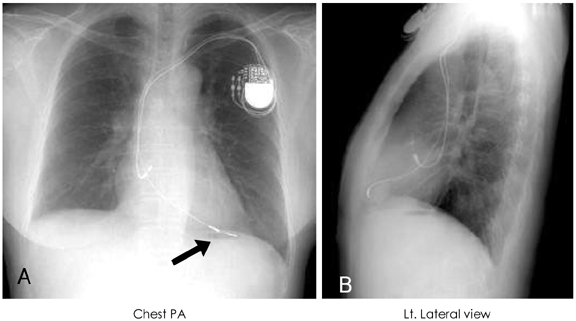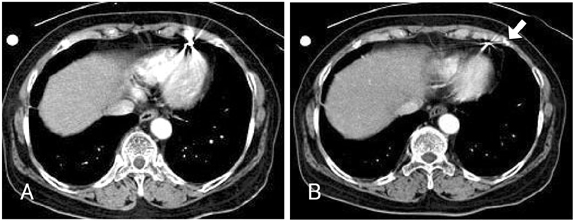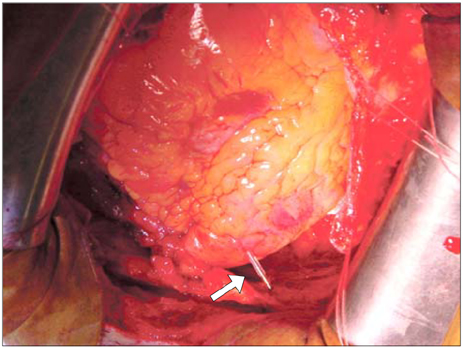Korean Circ J.
2007 Sep;37(9):453-457. 10.4070/kcj.2007.37.9.453.
Early Detection of Perforation of the Right Ventricle by a Permanent Pacemaker Lead
- Affiliations
-
- 1Division of Cardiology, Department of Internal Medicine, Sanggye Paik Hospital, Inje University Medical College, Seoul, Korea. cardiobk@sanggyepaik.ac.kr
- KMID: 2093984
- DOI: http://doi.org/10.4070/kcj.2007.37.9.453
Abstract
- Ventricular perforation is a rare complication of permanent cardiac pacemaker implantation. We report here on a 68-year-old woman with a dual chamber permanent pacemaker that had been implanted one month earlier, and she suffered cardiac perforation from the pacemaker lead. Frequent follow-up via12-lead surface electrocardiography and chest radiography and the proper work-up for pacemaker implantation are needed for detecting rare complications after pacemaker implantation.
Keyword
Figure
Reference
-
1. Ellenbogen KA, Hellkamp AS, Wilkoff BL, et al. Complications arising after implantation of DDD pacemakers: the MOST experience. Am J Cardiol. 2003. 92:740–741.2. Choi JH, Rhim CY, Hong KS, et al. Four cases of pericardial tamponade following percutaneous transluminal coronary angioplasty. Korean Circ J. 1999. 29:523–527.3. Parsonnet V, Bernstein AD, Lindsay B. Pacemaker implantation complication rates: an analysis of some contributing factors. J Am Coll Cardiol. 1989. 13:917–921.4. Aykol A, Aydin A, Erdinler I, Oguz E. Late perforation of the heart, pericardium, and diaphragm by an active-fixation ventricular lead. Pacing Clin Electrophysiol. 2005. 28:350–351.5. Mahapatra S, Bybee KA, Bunch TJ, et al. Incidence and predictors of cardiac perforation after permanent pacemaker placement. Heart Rhythm. 2005. 2:907–911.6. Zehender M, Buchner C, Meinertz T, Just H. Prevalence, circumstances, mechanisms, and risk stratification of sudden cardiac death in unipolar single-chamber ventricular pacing. Circulation. 1992. 85:596–605.7. Garcia-Bolao I, Teijeira R, Diaz-Dorronsoro I. Late fatal right ventricular perforation as complication of permanent pacing leads. Pacing Clin Electrophysiol. 2001. 24:1036–1037.8. Sanoussi A, El Nakadi B, Lardinois B, De Bruyne Y, Joris M. Late right ventricular perforation after permanent pacemaker implantation: how far can the lead go. Pacing Clin Electrophysiol. 2005. 28:723–725.9. Henrikson CA, Leng CT, Yuh DD, Brinker JA. Computed tomography to assess possible cardiac lead perforation. Pacing Clin Electrophysiol. 2006. 29:509–511.
- Full Text Links
- Actions
-
Cited
- CITED
-
- Close
- Share
- Similar articles
-
- Right Ventricular Perforation and Left Hemothorax by Permanent Transveneous Pacemaker Lead: Report of 1 Case
- A Unique Case of Non-Capture of Permanent Pacemaker Lead: Delayed Lead Perforation and Cardiac Tamponade
- Infected Endocarditis Related Pacemaker leads: A Case Report
- Permanent Pacemaker Lead Induced Severe Tricuspid Regurgitation in Patient Undergoing Multiple Valve Surgery
- A Case of Pacemaker Implantation after Balloon Venoplasty on Innominate Vein Stenosis







